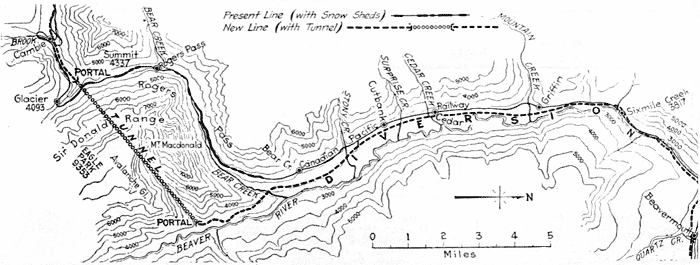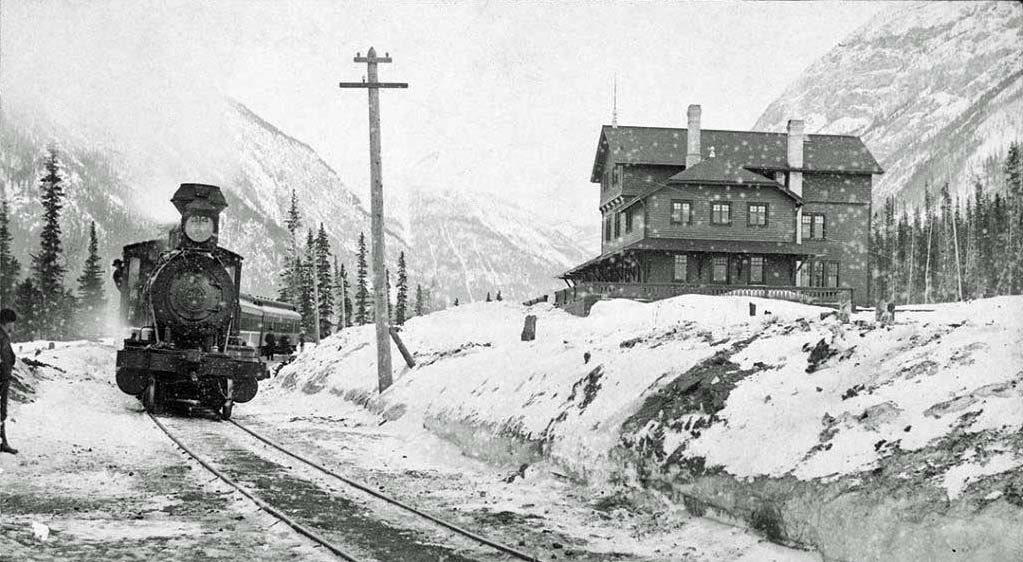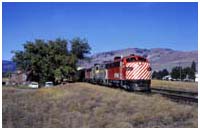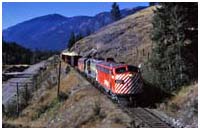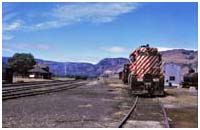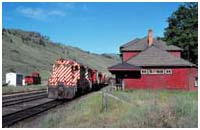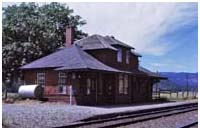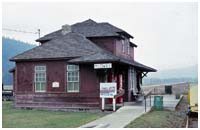 | Canadian Pacific Odds and Ends - Part 11 Articles |
Salvaging CPR's Old Line at Rogers Pass - Cdn Railway & Marine World 1917. The "Last Call" page has appeared weekly on OKthePK's web site over the past couple of years. Each week a different article told the story about various railway items of interest. While some of the articles were saved they were no longer available online. Several of those about the Canadian Pacific Railway have been compiled here on this page. There is insufficient room to display more than a few articles per page. As a result, "Canadian Pacific Odds and Ends - Part 11", continues this month with more possible parts to follow as time progresses. Every month they will be archived to the CPR Set-off Siding web site for future online retrieval. Look under the articles section on the CPR Set-off Siding web site to find these archived pages. 
Salvaging the Canadian Pacific Railway's Old Line at Rogers Pass The five mile Connaught tunnel, on the C.P.R. main line through the Selkirk Mountains in British Columbia, was opened for operation in December 1916. Its use made possible the abandoning of the old main line over Rogers Pass, with a consequent reduction in elevation of more than 500 feet. A large amount of curvature was also taken out and the distance considerably shortened. The old main line left the present line about three-quarters of a mile from the new tunnel's western portal, crossed the Illecillewaet River and Eagle Creek, followed the contour around the Cambie and Glacier loops, rising steadily on heavy grades through about two miles of snow sheds until the summit was reached at Rogers Pass. From Rogers Pass the line dropped to the east sharply, and from one mile east of Rogers Pass to Bear Creek, ran through practically continuous snow sheds for three miles and joined the new main line just east of Stony Creek. Old and New Lines, Canadian Pacific Railway, at Rogers Pass, B.C. The abandoned line comprised some 20 miles of track and sidings, 25,000 linear feet of snow sheds, and a considerable amount of miscellaneous property, including water and oil lines, telegraph lines, tool houses, water tanks, station buildings, and locomotive house equipment at Rogers Pass. Due to the abnormal conditions created by the war, the C.P.R. desired to salvage everything that would justify the expense of recovery. The general plan for the work was, first, the salvaging of snow sheds on each side of the summit, working down the hill both ways from Rogers Pass. The cribbing was to be left, as it was too firmly embedded in the side of the hill to be pulled loose without breaking, in addition to the probability that if taken out it would bring down the hill with it. Track was to be taken up, when the snow sheds were far enough ahead, so that the track gangs would not overtake the snow shed gangs. Miscellaneous structures were to be taken out as most convenient. All material, except such as might be loaded and sent direct to certain specified points on the line, was to be taken to Donald, B.C., in the Columbia River valley, as this was the nearest place having space enough available to store the amount of material which it was estimated was to be saved. The turning point of the work was the necessity of finishing it before the first snow fell, as there was every chance that if part of the line was left unprotected through the winter, with long stretches of snow sheds taken out, slides would make it impossible to go in again in the spring of 1918 and bring out the rest of the line. Before work began, in fact, three small slides, one of them about 250 feet long, were found to have already occurred and had to be cleared before the line could be used for work trains. The question of equipment was of first importance, due to the need for rapid work. It quickly developed that practically all the equipment would have to be improvised, as no standard equipment was available in the way of locomotive cranes or other rigs that might be used for wrecking the sheds. It was therefore decided to rely principally on skid derricks, working on top of, or alongside, the sheds. Eight of these were built, together with a derrick car, which was put together in Vancouver and shipped to the work. Overhead cable ways were considered, but believed to be too slow, particularly as it soon developed that the cribbing would stand if the sheds were removed, so that there was no immediate danger of slides and no need of keeping equipment up out of the way. A track laying machine was also considered for taking up track, but it was thought there was not sufficient work to justify its use. At the unloading and storage yard at Donald, a small, quick handling, movable derrick, of about 2 tons capacity, was installed, and one larger stationary derrick, with an 80 foot boom. Two reciprocating steam saws, with boilers, were set up for working the salvaged timber into shape. The sizes of the timber ran for the most part to 3 and 4 inch planks and 12, 14, and 16 inch square timbers from 20 to 30 feet long. The timber was delivered on flat cars at Donald, the cars being picked up daily at the various points where the derricks were working, by C.P.R. work trains operating over the hill until the track was broken, and afterward on the west slope, down over the Cambie loop and through the tunnel to Donald. Final decision to salvage the line was made by the C.P.R. late in July, and the last few days of the month were spent in repairing and refurnishing outfit cars, arranging for board and commissary matters, and getting equipment ready for the work. It was estimated that snow enough to shut down the work might be expected any time after 15 Oct 1917, and that there were, therefore, not more than 75 working days which could be safely counted upon. By the first week in August camps had been established at Cambie, Donald, and Rogers Pass, and work had begun on the snow sheds at several points on the West slope. Labour, although none too good, appeared plentiful, but it was difficult to get prompt deliveries on much needed equipment. By the second week in August, however, work was well under way on the sheds and some track and locomotive house material had been shipped from Rogers Pass yards. By the third week, 3,700 feet of snow shed were either partly of wholly wrecked, but it was becoming very difficult to hold labour, due to the higher rates that were being paid in the harvest fields. Men would ship to Rogers Pass, work for a few days and then drift on to the east. Instead of 300 or more men estimated as necessary for progress, the number dropped to 150, and several times to not more than 100. By the end of August, however, 6,500 feet of sheds were wholly or partially down, two miles of track were up, and a considerable amount of miscellaneous material had been loaded. Work was pushed with the small force available and by mid September seven derricks were at work, and all of the snow sheds on the west slope had been salvaged, except one shed above the old Glacier station, which on examination, was found to be worthless, and was marked for burning. Meanwhile the labour situation was slowly improving, as the harvest season advanced and more men drifted westward. During the next two weeks this improvement was reflected by increased progress, and by 1 Oct 1917, 16,000 feet of snow sheds had been partly or wholly salvaged. The main line track was broken at Rogers Pass on 18 Sep 1917, and by the end of the month 11 1/2 miles of track were up, and the west slope was practically clear of material. Outfits were then shipped promptly to the east slope, and every effort concentrated upon getting down the hill ahead of the snow. Derricks were placed as close together as they could be economically operated, and the track gangs followed immediately after the derricks. During the next week four miles of track were taken up, about half a mile of snow sheds were wrecked, and a large amount of piping and miscellaneous material were saved. Small portable houses, salvaged previously, were set up at Glacier and Stony Creek. By 15 Oct 1917, the date originally set as necessary to complete the work, 25,000 feet of snow sheds, less 5,000 feet marked for burning, had been salvaged, 18 out of 20 miles of track were up, and all miscellaneous work done except a little grubbing and burning. Equipment was loaded during the next few days, camps struck, and forces reduced. On 18 Oct 1917 the first snow fell at the pass. The work was done for the C.P.R. by Sydney E. Junkies & Company of Vancouver, under the direction of J.G. Sullivan, Chief Engineer Winnipeg, and H. Rindal, District Engineer Vancouver. The accompanying chart will give an idea of the general layout of the work. The bridges will be taken out by another contractor, probably during this year.  Life in the Pool 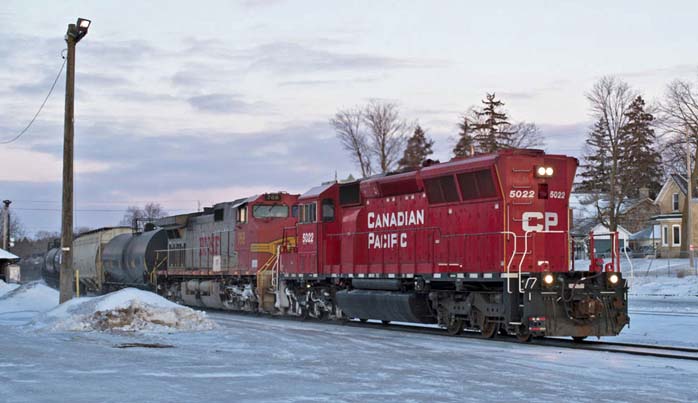 The train eastbound through Galt - Bill Miller. So, as 3 Mar 2019 rolls around, I will be reaching 33 years of service. 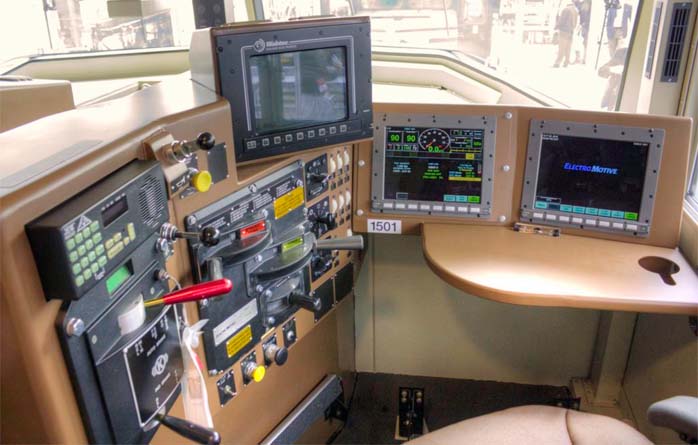 Locomotive controls - Photographer? Thus from London begins the long trip going backwards. 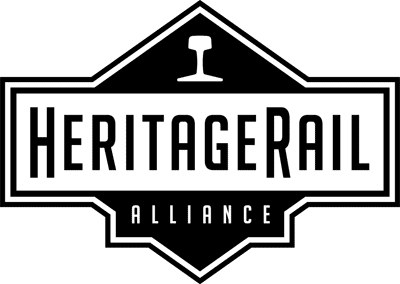 CP Archives to Exporail By Peter MurphyClick to enlarge photograph. The above photograph from the CP archives shows a westbound train at Field beside Mount Stephen House, one of the first three hotels (Glacier House and Fraser Canyon House) built by the Canadian Pacific Railway in 1885 and designed by Thomas Sorby. Due to the steep grade on the "Big Hill" east of Field, (about 4 percent at that time) heavy dining cars could not be hauled over that section of track. The hotel was designed as a simple meal stop between Banff and Golden. Between 1900 and 1902 the hotel underwent a major expansion designed by architect Francis Rattenbury. Sorby's small rectangular building was augmented with fifty new rooms, as well as amenities such as a billiards room and modern plumbing. Rattenbury changed Sorby's Alpine architecture to something closer to English Tudor design, adding gables and exposed wood beams - Circa 1886-1900 Photographer unknown Boorne and May Calgary - Provincial Archives of Alberta call number B 5927 - Glenbow Archives PD-5-576. 31 October 2018 Without any public fanfare, Canadian Pacific Railway Limited (CP) has donated its massive archival collection of documents, plans of bridges and structures, and photos to Exporail, the Canadian Railway Museum in Saint-Constant, Quebec, south of Montreal. 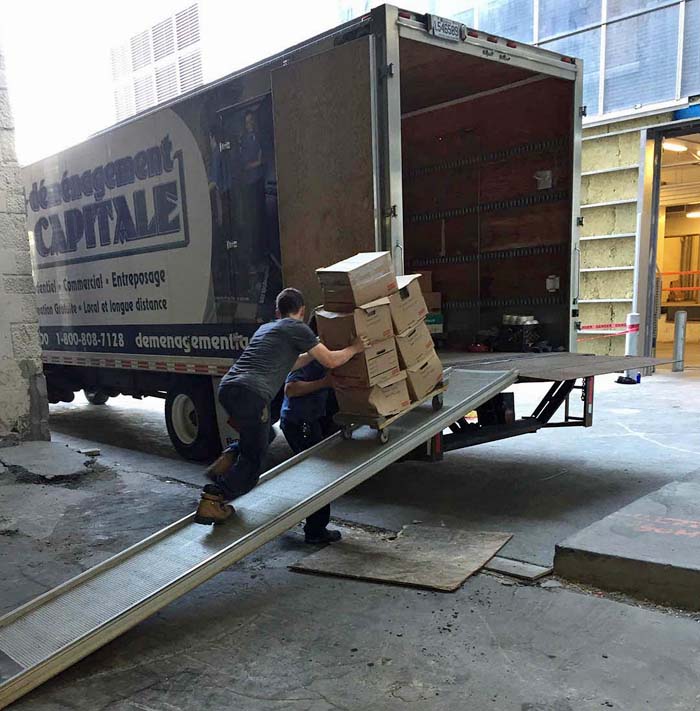 Moving archival material from Windsor Station to St. Constant - Date? Photographer? In 2014, the Canadian Cultural Property Export Review Board designated the archival collection as being of "outstanding significance and national importance" to Canada. 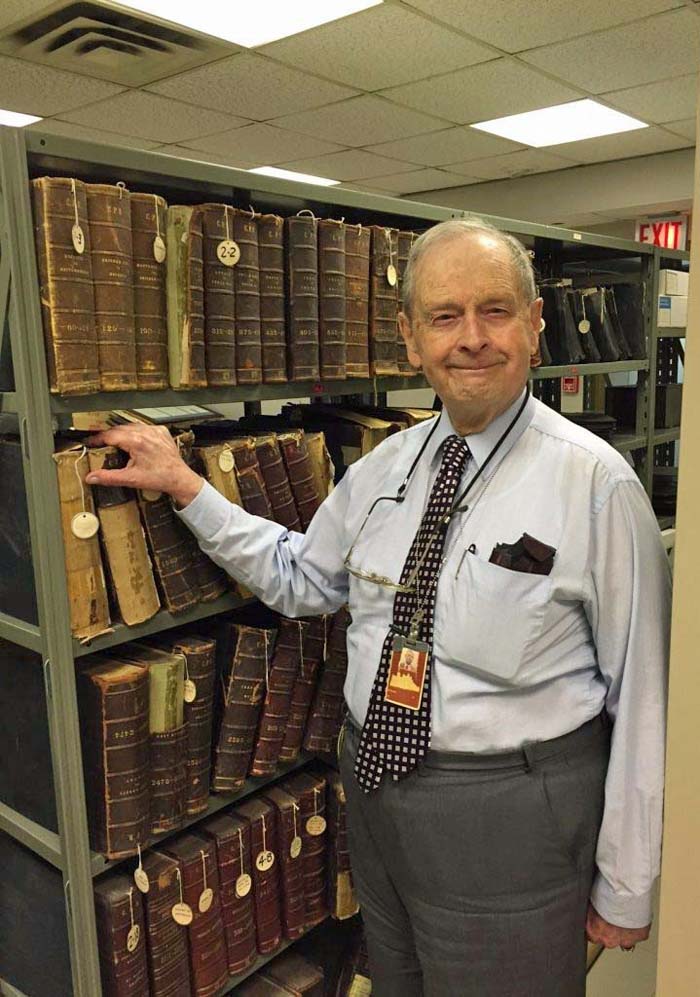 The late Ronald S. Ritchie CP retired and CP archives volunteer standing in front of the Heckman photographic albums (8 x 10 inch prints from the late 1880s) - Date? Photographer? The CP Fonds contain:
Employee records were not part of the donation to Exporail. 
Annual Passes for C.P.R. Employees 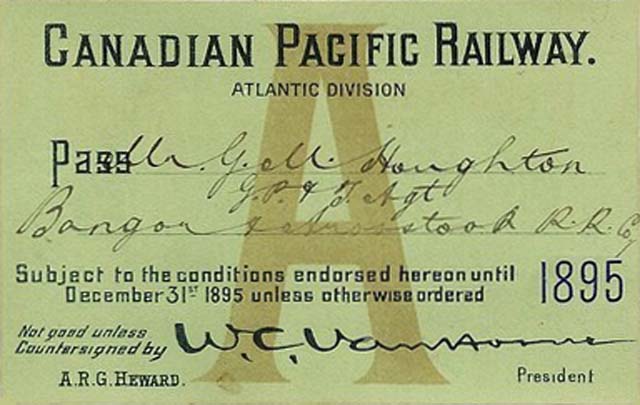 A Canadian Pacific Railway Atlantic Division pass signed by William Cornelius Van Horne - Date? Photographer? E.W. Beatty, K.C., President, C.P.R., has issued the following circular to officers and employees: Effective Mar. 1, annual passes will be granted to employees coming within the following classifications and will be made good also for employee's wife where desired (one pass for two persons). Employee on a general-superintendent's district, who has had continuous service for not less than 10 years, will be granted annual pass good over district on which employed. Such employee who has had continuous service for 20 years and over, will be allowed annual pass good over Eastern or Western Lines, upon whichever employed. Employee of any other department of the service will enjoy the same privilege as above, stating the territory over which pass desired. These privileges and conditions also apply to a pensioner, and to an employee who has been reinstated or re-employed, not out of the service for more than 12 consecutive months, and given seniority upon return. Women employees will be treated the same as male employees, except that passes will be good for themselves only. Upon certain trains, such as 7 and 8, these passes will not be honoured. The company's general pass regulations will continue in force, except in respect of the employees above mentioned. 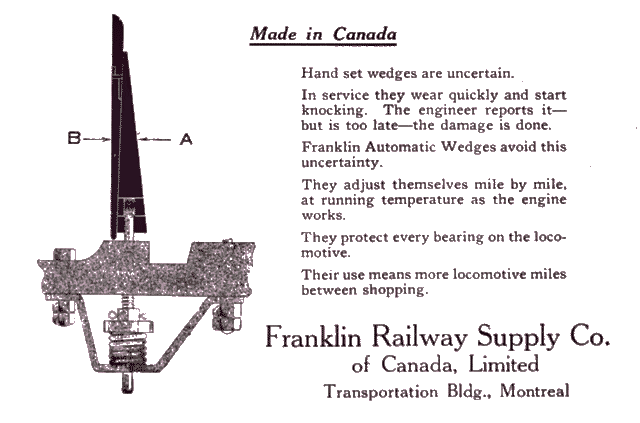  Trip Fuel Optimization 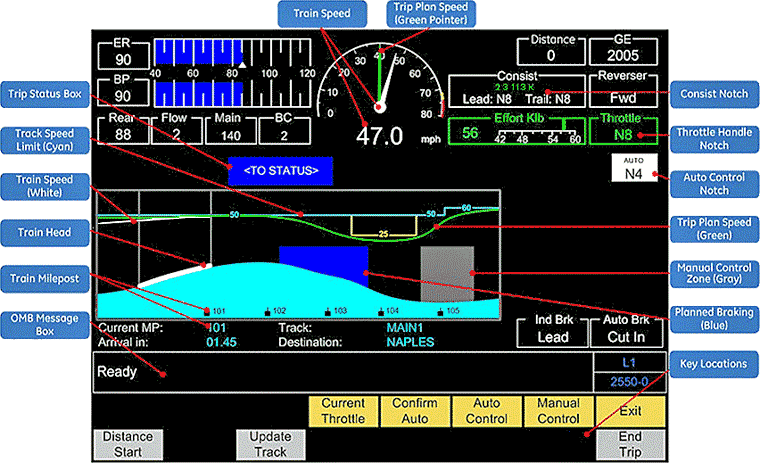 Screen capture - Transportation Safety Board. Most railways today are now using a form of automated train control that produces the best fuel conservation for any given trip.
Once updated, FTO develops a trip plan for the trip. 
Midway British Columbia The summer of 1972 was my first summer of working in the running trades for Candian Pacific Railway (CP) at Revelstoke. I came west with fellow Montrealer Ken Goslett, who got a clerking job in the yard office at Revelstoke. We both planned to return to school in September. A strike by the International Woodworkers of America (IWA) later in the summer saw us laid off in mid-August, so we went travelling. A visit to Nelson saw lines of Canadian Locomotive Company (CLC) Fairbanks Morse (FM) diesels stored because of reduced traffic levels. At that time the west end of the Kootenay Division was at Midway, British Columbia, where traffic was handed over to the Kettle Valley Division crews from Penticton. These first two images show an eastbound freight at Midway on the main line in front of the station and bunkhouse on 31 Aug 1972, and a few miles east of Midway near Boundary Falls, once the site of a copper smelter. An eastbound freight at Midway and then near Boundary Falls - 1972 Phil Mason. The use of F units in place of the C-Liners was unusual and didn't happen often. After CP ceased operating through freights over the Carmi Subdivision east from Penticton, once a week a Penticton crew would taxi east to Midway, then head a train west to the Pope & Talbot mill just west of Midway. Sometimes they'd go another twenty or so miles west to Beaverdell to pick up carloads of dolomite used as flux in the Trail smelter. This third picture from 1974 shows a GP9 on the shop track at Midway with a Penticton caboose, plus on OCS tank car of fuel. The station and yard visible in the background. Sometime in 1974, CP and the operating unions took the "operating off the main line" issue before the arbitrator regarding two issues on the Boundary Sub. I think the timing of the issue related to the retirement of the last operating employee to have Grand Forks seniority. Eholt and later Grand Forks were subsidiary terminals to Nelson until a mid-century date. The issue was the 4.5 mile long Carson Spur which connected Grand Forks on the CP Boundary Sub to the GN line from Kettle Falls, Washington, USA, to Grand Forks BC and Republic, Washington. The Carson Spur was originally yet another railway that the CP had absorbed. Anyhow, until 1974, any road crew from Nelson operating a train to the GN interchange got a 100 mile "operating of the main line" bonus. The Grand Forks based switcher crew didn't get the bonus, so as long as there was a Grand Forks operating employee, CP kept the switcher operating. Finally, it was decided that Nelson freight crews would carry out the switching at Grand Forks, and for awhile CP paid the bonus but CP took the issue to arbitration, and won the case. Trains could operate 4.5 miles off the main line without receiving the bonus pay. Coincidentally, this 4.5 miles limit also covered the distance to the mill west of Midway on the Carmi Sub. Sometime in 1975, the Nelson crews took over the switching at the mill west of Midway, so the practice of leaving a locomotive and caboose at Midway ceased. Although the rest of the Boundary Sub was abandoned in 1988, operations from Grand Forks to Midway had ceased a few years earlier. Today the station and a wooden caboose are preserved at Midway. On 17 Jun 1977 we operated westbound train number 53 all the way from Robson West near Castlegar to Midway. Here's the train passing Midway station. In those days, the train would pull down the main and back into the yard. The mystery here was, why were there loads on the train picked up at Grand Forks? I think the Pope & Talbot shed track in Grand Forks may have been connected only at the west end. Any switching required at Midway mill would take place before going off duty in the evening so the train would be made up for the following days return trip. The shop track is visible in the background, with just one caboose on it. I think it was a Penticton caboose left there from the days when a Penticton crew taxied over and switched the mill which was in their territory. It may be the one that is preserved there today. Here's the station at Midway in 1974 and thirty years later after preservation. I'm sad because the big tree, which must have helped keep the station cool, did not survive. By the time I worked the Boundary Sub in 1975, the Grand Fork operator also worked Midway, and a mobile CSC agent had a company car with a powerful radio kept in touch with us from Christina Lake to Midway. Like Grand Forks one valley east, Midway sits right on the Canada-US Border. 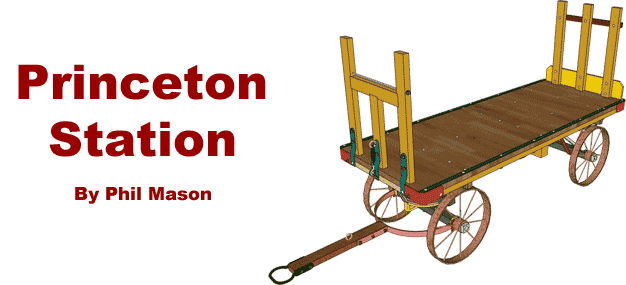 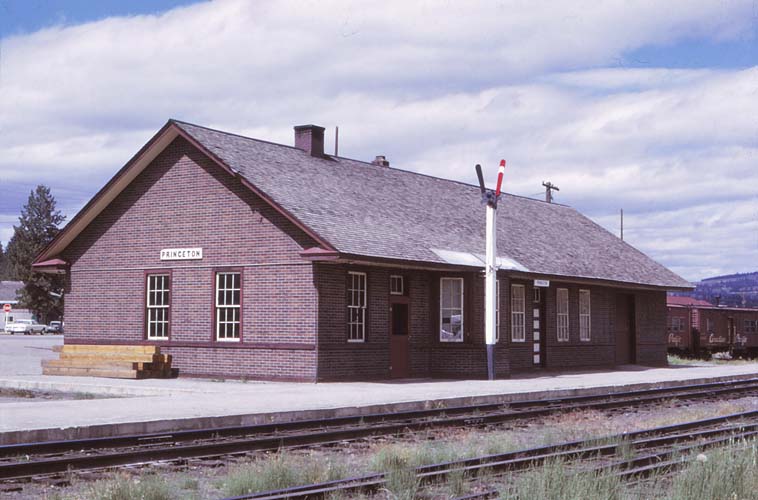 Princeton Station - 1974 Phil Mason. James Jerome Hill and his Great Northern Railway (GN), under the charter Vancouver, Victoria & Eastern Railway built into southwestern British Columbia ahead of the Canadian Pacific Railway (CP). CP could find no easy route west from Princeton so instead elected for trackage rights over the GN to Coalmont, where the GN owned a coal mine for steam locomotive coal. In exchange, the GN was granted trackage rights over CP's planned Kettle Valley Railway (KVR) Coquihalla route over the Coast Mountains. The legend says that following the change of GN leadership from J.J. Hill to his son Louis, the GN operated a single special over the Coquihalla route, and by 1933 ceased operating to Princeton from the south. CP acquired the GN trackage from Princeton, along with several GN standard plan stations. The ex-GN Princeton station remained in use until the end of CP's Princeton Subdivision in 1989, although the operator was removed in the late 1970's. The images show Princeton station in 1974, sometime in the 1980's after the operator had been abolished, but the station was still used by track forces, and finally after abandonment. The station survives today as a Subway sandwich shop. Princeton was the junction for a branch to Copper Mountain, and a location for a commissary and dining car setout track. To lighten the load over the several grades on the southern British Columbia route, the passenger train had a dining car from Princeton to Robson West (near Castlegar). I'm not sure what happened east of Nelson. 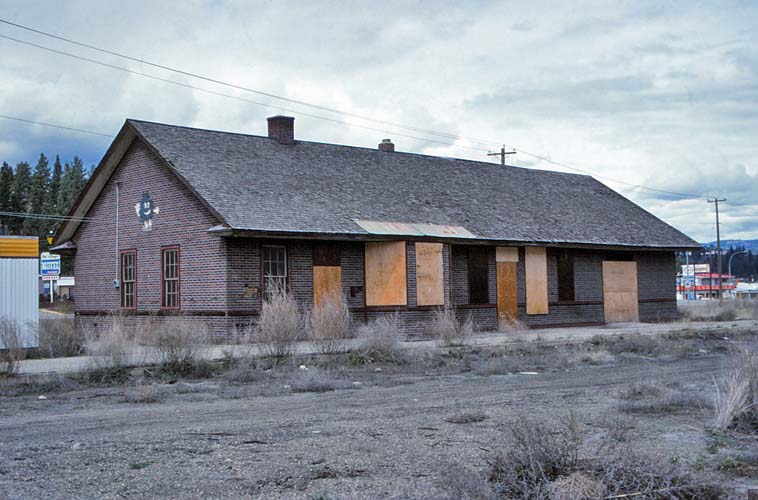 Princeton Station - Circa 1980 Phil Mason. 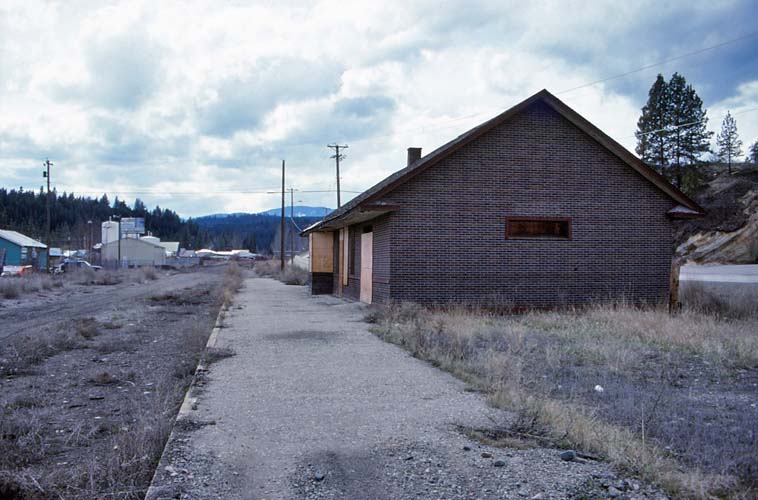 Princeton Station - Circa 1980 Phil Mason. 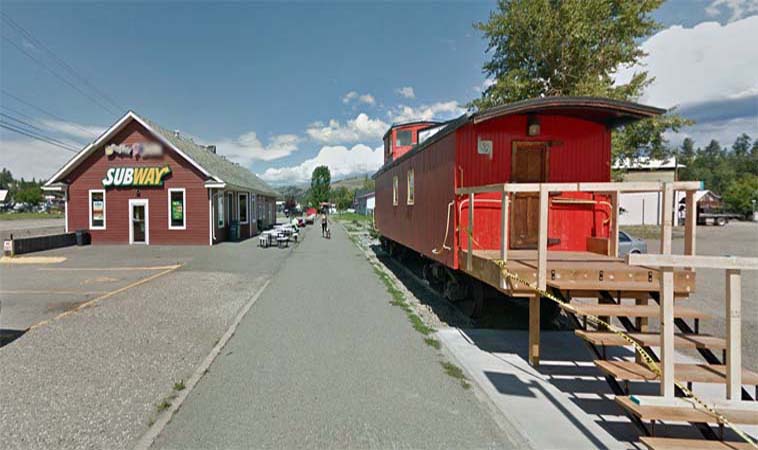 Princeton Station and ex-CP caboose - Date? Google Street View. 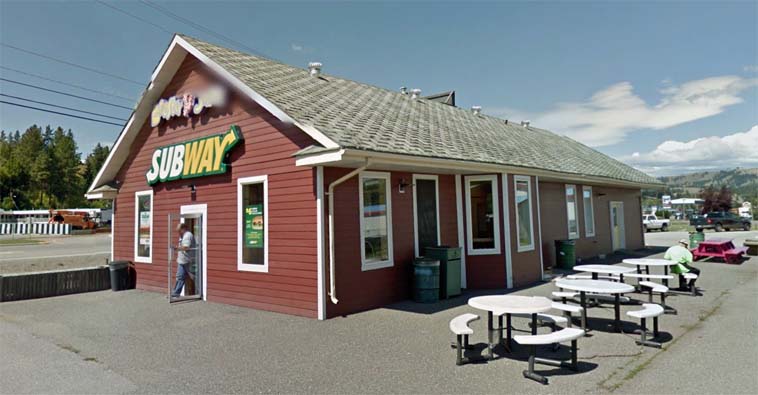 Princeton Station. The Booster Juice sign is blurred out so one would guess they didn't pay Google - Date? Google Street View. 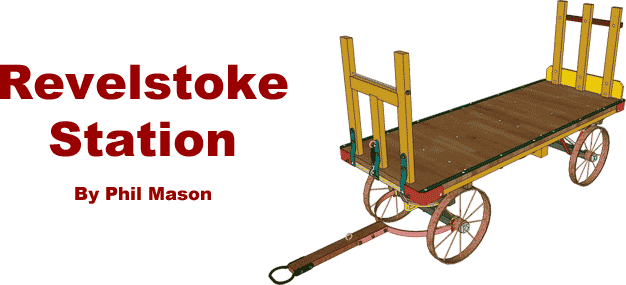 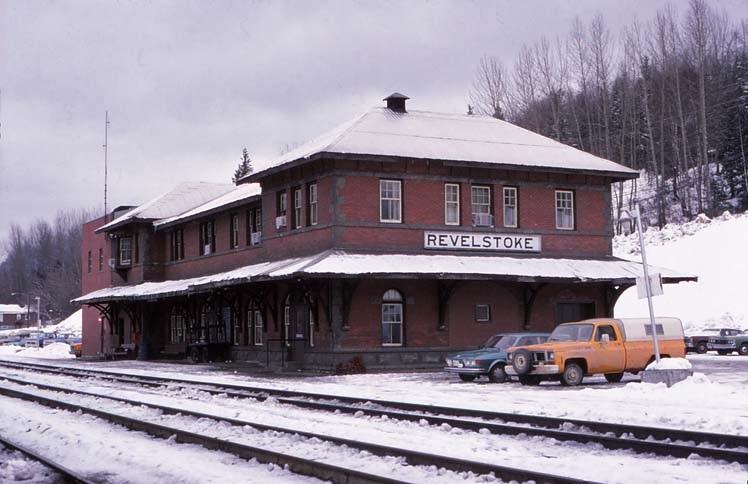 This building was the third Revelstoke station, built in 1923 and replaced in 1978 with the 1966 extension visible at the far end - Date? Phil Mason. Revelstoke crews ran east to Field and Golden and west to Kamloops. Like Calgary, Revelstoke was not always an administrative centre on the railway, but was always a crew base. Before 1899, the subdivisions were Gliechen to Canmore, Alberta, Canmore to Donald, British Columbia, and Donald to Revelstoke. Both Field and Rogers Pass had crew bases to operate pusher services. 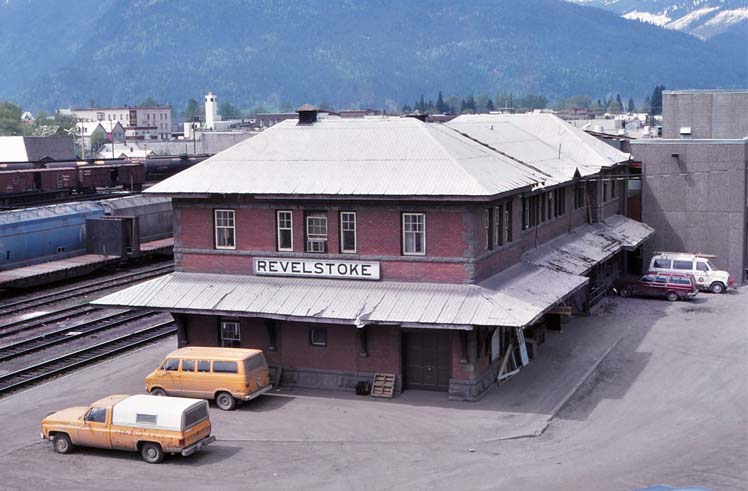 The east end of the 1923 built station - Date? Phil Mason. In 1966, a brick extension was built onto the west end of the 1923 building to house the newly installed CTC machinery and house the rail traffic controllers office. I spent over thirty years based as a trainman, conductor, and locomotive engineer out of this building and the later replacement. The 1923 building was simply too small for all the staff offices in the building in 1978. By the time I retired in 2005, the new building was virtually empty. The RTC office moved to Calgary in 1995 followed shortly by the clerical staff to Winnipeg and Calgary. I was always intrigued by the small bay window at the west end of the second story. I was told that was the location of the old train dispatchers office, and the chief dispatcher requested a window like that. When the new fourth station was built in 1978, the 1966 extension was incorporated into it. The work carried out without having to close the RTC office. However, the interior of the office was modified while the RTC's were working.  Shuswap Subdivision RTC Vic Hootnik is shown at his desk. Vic started his career at Stoney Creek BC as an operator. - Date? Phil Mason. One day I was out on a train, and RTC Vic Hootnik was on the point to train radio. There was hammering and banging in the background. Suddenly he said "Don't remove that support, it's holding up the CTC machine", followed quickly by "Holy s--t!" and a huge crash. The signals across the Shuswap Sub all went dead. In attempting to move the desk, the bridge and building department caused it to fall over. The radio console still worked, so after everyone picked themselves up off the floor, the CTC was restored in about an hour. My images with this article were all taken shortly before the third, 1923 built station, was demolished. Phil Mason 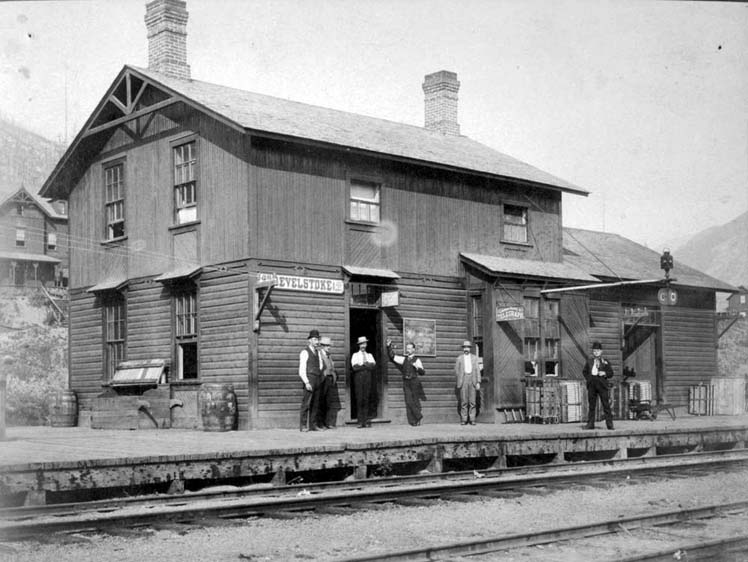 An early Revelstoke station - Circa 1900 Photographer unknown - BC Archives. 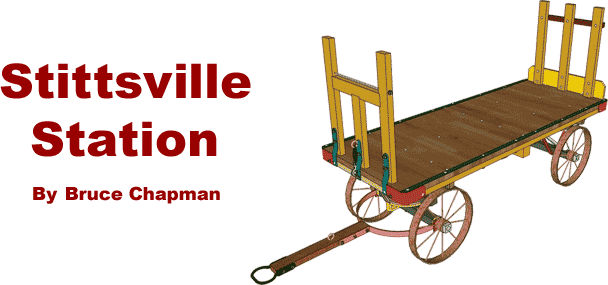 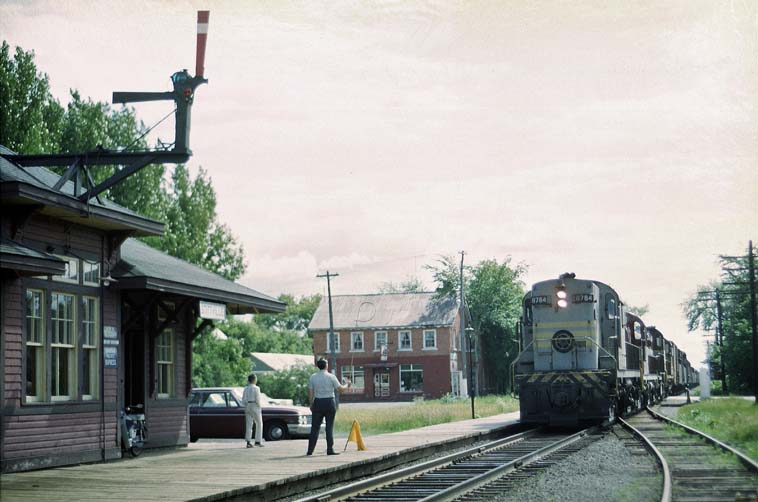 Orders for CP Train 90 at Stittsville Station - 19 Jul 1965 Bill Linley. My first operator's job outside of the Ottawa Terminals (now a part of Ottawa) was at Stittsville, Ontario, (it was once called Stittvile) 14 miles west of Ottawa West station relieving the agent Craig Hobbs for his 2 weeks of annual vacation. At the time, my transportation was that little 65 cc Honda motorcycle on the platform. Train number 262, the day RDC from Brockville, had gone by an hour earlier with RDC number's 9066 (RDC-1) and 9022 (RDC-3), and he arrived at Ottawa West at 14:54, according to the the register book that I have for that day. The day freight from Smiths Falls, Train 90, had still not gone by, and Train 263, the afternoon pool train for Brockville was due out of Ottawa West at 15:44. The train dispatcher at Smiths Falls, "Mac" McLean (code RSM), rings me and says, "Take a 19Y east copy 3". I put the train order signal at red, as it is only a 2 indication train order signal, and respond "SDR East" (Signal Displayed Red). He gives me an order, "No. 263 eng 8481 wait at Ottawa West until 16:00 for No. 90 eng 8784". Before long, Train 90 is on the horizon, so I clear him with this order, and get out the 2 hoops and the yellow flag. The rule book states that a train order office with a 2 indication train order signal, upon the approach of a train, the operator must display a yellow flag by day and a yellow light by night when there are no 19R train orders held for that train. Carrying 2 hoops and the yellow flag is a pain, so I jam the flag on a staff into a crack in the wooden platform, and that is what you see here in the photo. Both the head-end and tail-end got their hoops OK, and the register book shows that he arrived at Ottawa West at 15:40 with 38 loads, 46 empties, and 3542 tons. Train 263 arrived at Ottawa West at 15:49 and left at 15:52 with 5 cars. Then Train 1 went by Ottawa West at 16:12, 20 minutes later on Train 263's block with locomotive numbers 1426, 1908. and 1406 with 15 cars.  Multi Purpose Machines By Andy Cassidy During the holiday shutdown period, Maintenance Of Way (MOW) equipment is tied up at various places. Over the holiday season Canadian Pacific Railway's new Multi Purpose Machine (MPM) was tied up at the new MOW shop in the CP Coquitlam Yard, (Mile 111.9 on the CP Cascade Sub), before it went back to work in the new year. 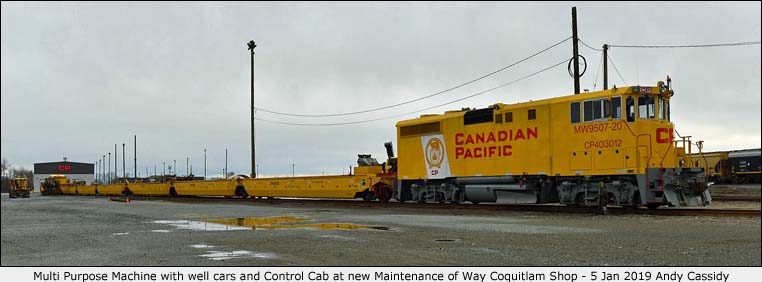 CP decided to build three of these MOW MPM's consisting of a converted GP38AC locomotive for power, connected well cars for the work platform, and a Control Cab made from an 89 foot flat that also stores the excavator attachments. The excavator runs back and forth along the length of the attached well cars doing its thing with the various attachments. 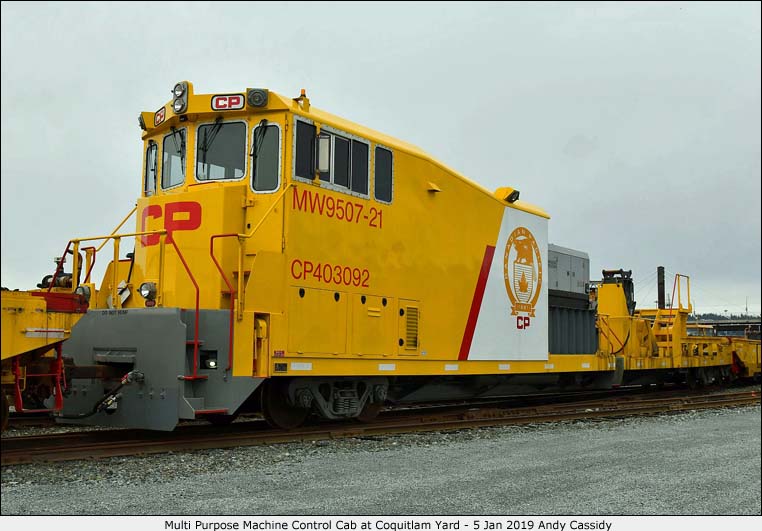 The locomotive can also be run by belt pack for remote operations. In this case the train is MW9507-20, and they used ex-CP 3005 (GP38AC, the old Green Machine in Coquitlam) to build the new CP 403012 power unit. The Control Cab is number CP 403092. Seen here are the photos taken near the car shop. 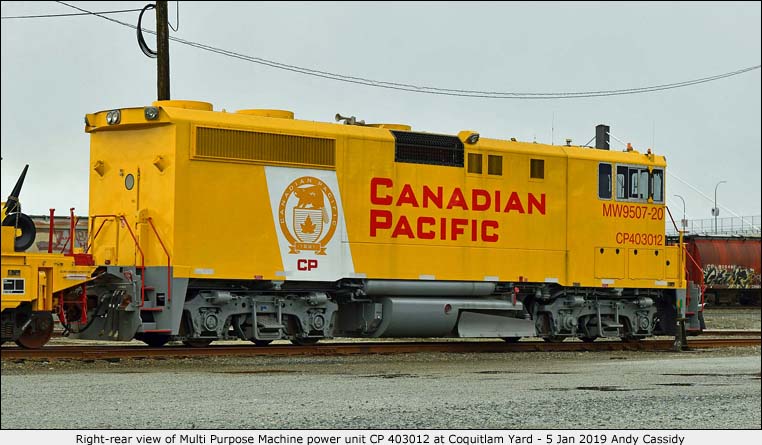 Also shut down over the holiday period, the equipment below was parked over on the Mayfair Spur, off the CP Westminster Subdivision at Mile 2.5. It's the same basic machine as the CP version, just not as fancy looking. Over the past month it's been running around the Greater Vancouver area doing work here and there. Andy Cassidy 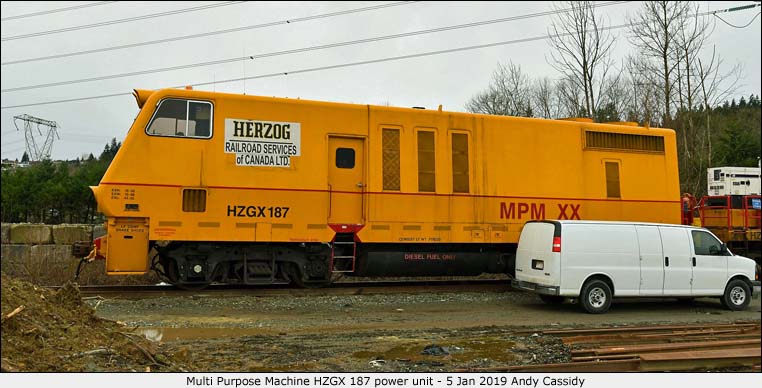  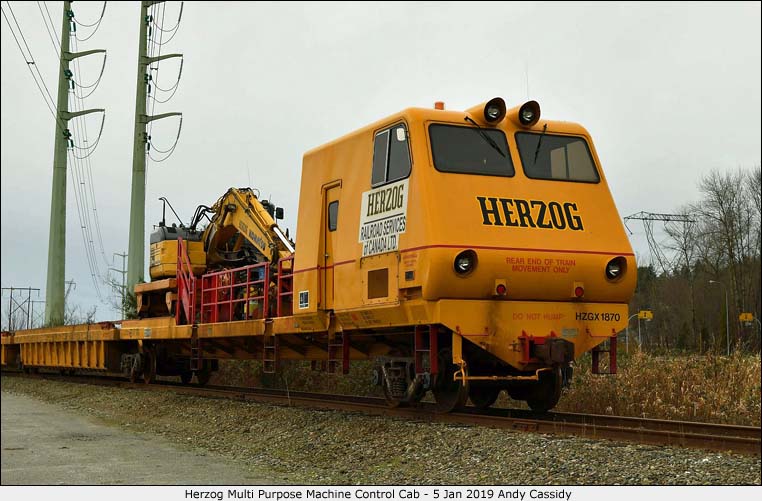  Cars Scrapped for Parts By Andy CassidyYou may recall in May 2019 the National Railroad Heritage Society (NRHS) sold its cars to the Heber Valley Railroad of Utah. |
